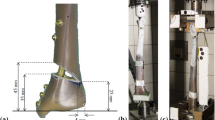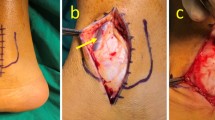Abstract
Background
With ankle arthritis often affecting young patients, joint-sparing treatments instead of total joint replacement should be considered. Only a few implants were specially developed for supramalleolar osteotomies (SMOT). This study was performed to analyse the stability of different implants and their appropriateness for SMOT.
Methods
Twenty-five bone models (Sawbone Europe, Malmö, Sweden) were used for biomechanical testing. SMOT were performed as a uniplanar osteotomy, leaving 5 mm of lateral bone intact with a standardized gap of 8 mm. Five different plates commonly used for SMOT were assessed. For axial stability, the constructs were tested during 100 cycles for each load (150N and 800N) at a rate of 0.5 Hz. For rotational stability, each construct was subject to 100 cycles of 5 Nm torque at a rate of 0.25 Hz, performing three runs with an axial preload of 0N, 150N, or 800N. Ultimate axial load was performed for one-half and ultimate rotational load was performed for the other half of the constructs. In addition, the stiffness of the different constructs after failure was tested.
Results
All constructs showed high stability and could be tested until maximum cyclic load. There was no significant difference between the five plates, neither for stiffness (axial or rotational) nor for failure load (axial or rotational). One plate indicated superiority in axial failure testing without any significant difference.
Conclusion
All implants could be tested until maximum load. The intact hinge apparently provides enough support to compensate for lower moment of inertia of some plates.
Level of evidence
Not applicable.



Similar content being viewed by others
References
Agneskirchner JD, Freiling D, Hurschler C, Lobenhoffer P (2006) Primary stability of four different implants for opening wedge high tibial osteotomy. Knee Surg Sports Traumatol Arthrosc 14(3):291–300
Brinkman JM, Hurschler C, Agneskirchner JD, Freiling D, van Heerwaarden RJ (2011) Axial and torsional stability of supracondylar femur osteotomies: biomechanical comparison of the stability of five different plate and osteotomy configurations. Knee Surg Sports Traumatol Arthrosc 19(4):579–587
Brinkman JM, Hurschler C, Staubli AE, van Heerwaarden RJ (2011) Axial and torsional stability of an improved single-plane and a new bi-plane osteotomy technique for supracondylar femur osteotomies. Knee Surg Sports Traumatol Arthrosc 19(7):1090–1098
Buda R, Castagnini F, Cavallo M, Ramponi L, Vannini F, Giannini S (2016) “One-step” bone marrow-derived cells transplantation and joint debridement for osteochondral lesions of the talus in ankle osteoarthritis: clinical and radiological outcomes at 36 months. Arch Orthop Trauma Surg 136(1):107–116
Coventry MB, Ilstrup DM, Wallrichs SL (1993) Proximal tibial osteotomy. A critical long-term study of eighty-seven cases. J Bone Joint Surg Am 75(2):196–201
Cristofolini L, Viceconti M (2000) Mechanical validation of whole bone composite tibia models. J Biomech 33(3):279–288
Heiner AD, Brown TD (2001) Structural properties of a new design of composite replicate femurs and tibias. J Biomech 34(6):773–781
Korner D, Gueorguiev B, Niemeyer P et al (2017) Parameters influencing complaints and joint function in patients with osteochondral lesions of the ankle-an investigation based on data from the German Cartilage Registry (KnorpelRegister DGOU). Arch Orthop Trauma Surg 137(3):367–373
Korovessis P, Katsoudas G, Salonikides P, Stamatakis M, Baikousis A (1999) Medium- and long-term results of high tibial osteotomy for varus gonarthrosis in an agricultural population. Orthopedics 22(8):729–736
Krahenbuhl N, Zwicky L, Bolliger L, Schadelin S, Hintermann B, Knupp M (2017) Mid- to long-term results of supramalleolar osteotomy. Foot Ankle Int 38(2):124–132
Lee OS, Ahn S, Lee YS (2017) Effect and safety of early weight-bearing on the outcome after open-wedge high tibial osteotomy: a systematic review and meta-analysis. Arch Orthop Trauma Surg 137(7):903–911
Miller BS, Dorsey WO, Bryant CR, Austin JC (2005) The effect of lateral cortex disruption and repair on the stability of the medial opening wedge high tibial osteotomy. Am J Sports Med 33(10):1552–1557
Nha KW, Lee SH, Rhyu IJ et al (2016) Safe zone for medial open-wedge supramalleolar osteotomy of the ankle: a cadaveric study. Foot Ankle Int 37(1):102–108
Pagenstert GI, Hintermann B, Barg A, Leumann A, Valderrabano V (2007) Realignment surgery as alternative treatment of varus and valgus ankle osteoarthritis. Clin Orthop Relat Res 462:156–168
Pape D, Lorbach O, Schmitz C et al. (2010) Effect of a biplanar osteotomy on primary stability following high tibial osteotomy: a biomechanical cadaver study. Knee Surg Sports Traumatol Arthrosc Off J ESSKA 18(2):204–211
Schmid T, Zurbriggen S, Zderic I, Gueorguiev B, Weber M, Krause FG (2013) Ankle joint pressure changes in a pes cavovarus model: supramalleolar valgus osteotomy versus lateralizing calcaneal osteotomy. Foot Ankle Int 34(9):1190–1197
Spahn G, Muckley T, Kahl E, Hofmann GO (2006) Biomechanical investigation of different internal fixations in medial opening-wedge high tibial osteotomy. Clin Biomech (Bristol Avon) 21(3):272–278
Stamatis ED, Cooper PS, Myerson MS (2003) Supramalleolar osteotomy for the treatment of distal tibial angular deformities and arthritis of the ankle joint. Foot Ankle Int 24(10):754–764
Takakura Y, Takaoka T, Tanaka Y, Yajima H, Tamai S (1998) Results of opening-wedge osteotomy for the treatment of a post-traumatic varus deformity of the ankle. J Bone Joint Surg Am 80(2):213–218
Valderrabano V, Horisberger M, Russell I, Dougall H, Hintermann B (2009) Etiology of ankle osteoarthritis. Clin Orthop Relat Res 467(7):1800–1806
Funding
All plates were sponsored by the manufacturers.
Author information
Authors and Affiliations
Corresponding author
Ethics declarations
Conflict of interest
The authors declare that they have no conflict of interest.
Ethical approval
This article does not contain any studies with human participants or animals performed by any of the authors.
Informed consent
Informed consent was obtained from all individual participants included in the study.
Rights and permissions
About this article
Cite this article
Ettinger, S., Schwarze, M., Yao, D. et al. Stability of supramalleolar osteotomies using different implants in a sawbone model. Arch Orthop Trauma Surg 138, 1359–1363 (2018). https://doi.org/10.1007/s00402-018-2981-2
Received:
Published:
Issue Date:
DOI: https://doi.org/10.1007/s00402-018-2981-2




